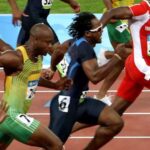Professional athletes and trainers are leading the new wave of sports tech. From game preparation to player development, sports strategies have advanced. More precise and realistic software now improves tactical analysis and sports performance. It lets players learn from on-field situations. The analytics revolution is changing how athletes train. It has made once-exclusive equipment available to all. This includes elite athletes and casual runners. Technology has changed the way athletes prepare and play sports. One of the most significant advances is performance monitoring. You can now upload your entire fitness regimen for in-depth analysis.
In recent years, tech has become smaller and more durable. It’s also less burdensome, especially in athletics. Wearable tech now helps prevent injuries. GPS tracks movements. Smartphones keep everyone connected. Data from sensors is sent in real-time to the trainer’s tablet. Technology has boosted athletic potential compared to old-school whiteboards and post-practice reviews. Technology is changing sports training. It tracks performance in real time. It also improves movement, communication, and injury prevention. These advancements also drive more interest in sports betting on platforms like casadeaposta.com.pt/bonus-casino/.
Check Performance
Trainers in sports can now monitor performance in real time. They use sensors on athletes’ bodies or in “smart clothing.” These provide real-time metrics. They can then pinpoint areas to focus on and adjust during practice. They can then decide whether to rest, stretch, or train harder. Many facets of the field of sports training now use lasers and GPS. Trainers may test athletes’ exact location, distance, speed, and acceleration. This can help find areas to improve beyond their times and splits.
Making Athletic Movements Perfect
It improves skills by analyzing unseen events and movements in sports. Bikers can now wear heads-up display (HUD) glasses while riding. They send accurate info on heart rate, speed, elevation, and other cycling factors. These metrics can help the cyclist. They allow for mid-ride adjustments.

Divers and swimmers compete in a technical sport incorporating sensors into training. The sensors measure more than time and effort when swimming or diving. These values correspond to leg motion, dive angle, spin rate, and hydrodynamics. This new movement tracking lets coaches help players improve. They might only improve by a few milliseconds, but a millisecond can make all the difference in a race.
Improved Communication
Applications like YouTube have also improved training communication. On YouTube, you can discover and share various workout sessions and gameplay videos. Athletes and coaches can upload and view the videos they need. They can do this during practice or on their own time. It will support education by studying films or debating plays.

Other tools, like MyFitnessPal, have improved communication even further. You can access these health, food, and exercise logs on a smartphone or computer. Trainers may use MyFitnessPal to track athletes’ diets. Athletes must manage their own training.
Getting Rid of Injuries
The main benefit of using tech in sports training is fewer injuries and faster injury detection. Tech has many perks. It can improve monitoring, movement, and communication. It also helps create environments that are less prone to damage.
Training management software can benefit coaches and trainers. It tracks all aspects of training, like diet, energy, and sleep. By defining best practices, they can reduce fatigue and injuries. Despite uncontrollable external factors, injury-free sports can become a reality.
Data Sports Group is a premier provider of sports data. Its relevant data analysis has helped many businesses grow.
When we interact with clients, we must remember this: the audience will take in the sports info before the experience. Companies can rely on Data Sports Group for all their data needs. Their platform will get consistent, high-quality data.
























































































